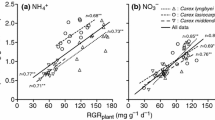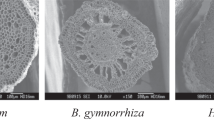Abstract
Plants growing in waterlogged environments are subjected to low oxygen levels around submerged tissues. While internal oxygen transport has been postulated as an important factor governing flooding tolerance, respiration rates and abilities to take up oxygen under hypoxic conditions have been largely ignored in plant studies. In this study, physiological characteristics related to internal oxygen transport, respiration, and oxygen affinity were studied in low intertidal marsh species (Spartina alterniflora and S. anglica) and middle to high intertidal species (S. densiflora, S. patens, S. foliosa, a S. alterniflora × S. foliosa hybrid, S. spartinae, and Distichlis spicata). These marsh plants were compared to the inland species S. pectinata and the crop species rice (Oryza sativa), corn (Zea mays), and oat (Avena sativa). Plants were grown in a greenhouse under simulated estuarine conditions. The low marsh species S. anglica was found to transport oxygen internally at rates up to 2.2 μmol O2 g fresh root weight−1 h−1. In contrast, marsh species from higher zones and crop species were found to transport significantly less oxygen internally, although rice plants were able to transport 1.4 μmol g−1 h−1. Under hypoxic conditions, low marsh species were better able to remove dissolved oxygen from the medium compared to higher marsh species and crops. The oxygen concentration at which respiration rates declined due to limited oxygen (Pcrit) was significantly lower in low marsh species compared to inland and crop species; Pcrit ranged from <4 μM O2 in the low marsh species S. anglica up to 20 μM in the inland species corn. Flooding-sensitive crop species had significantly higher aerobic respiration rates compared to flooding-tolerant species in this study. Crop species took up 3.6–6.7 μmol O2 g−1 h−1 while all but one marsh species took up <3.5 μmol O2 g−1 h−1. We conclude that oxygen transport, aerobic demand, and oxygen affinity all play important and interrelated roles in flood tolerance and salt marsh zonation.




Similar content being viewed by others
References
Allam AI, Hollis JP (1972) Sulfide inhibition of oxidases in rice roots. Phytopathology 62:634–639
Arenovski AL, Howes BL (1992) Lacunal allocation and gas transport capacity in the salt marsh grass Spartina alterniflora. Oecologia 90:316–322
Armstrong W (1964) Oxygen diffusion from the roots of some British bog plants. Nature 204:801–802
Armstrong W (1979) Aeration in higher plants. Adv Bot Res 7:225–332
Armstrong W, Gaynard TJ (1976) The critical oxygen pressures for respiration in intact plants. Physiol Plant 37:200–206
Armstrong W, Webb T (1985) A critical oxygen pressure for root extension in rice. J Exp Bot 36:1573–1582
Armstrong W, Brandle R, Jackson MB (1994) Mechanisms of flood tolerance in plants. Acta Bot Neerl 43:307–358
Ayres DR, Zaremba K, Strong DR (2004) Extinction of a common native species by hybridization with an invasive congener. Weed Technol 18:1288–1291
Berry LJ, Norris WE Jr (1949) Studies in onion root respiration I. Velocity of oxygen consumption in different segments of root at different temperatures as a function of partial pressure of oxygen. Biochim Biophys Acta 3:593–606
Bertness MD (1991) Zonation of Spartina patens and Spartina alterniflora in a New England salt marsh. Ecology 72:138–148
Boyer JS (1982) Plant productivity and environment. Science 218:443–448
Bray EA, Bailey-Serres J, Weretilnyk E (2000) Responses to abiotic stresses. In: Buchanan BB, Gruissem W, Jones RL (eds) Biochemistry and molecular biology of plants. American Society of Plant Physiologists, Rockville, pp 1158–1203
Brix H, Sorrell BK (1996) Oxygen stress in wetland plants: comparison of de-oxygenated and reducing root environments. Funct Ecol 10:521–526
Burdick DM, Mendelssohn IA (1987) Waterlogging responses in dune, swale and marsh populations of Spartina patens under field conditions. Oecologia 74:321–329
Castillo JM, Fernandez-Baco L, Castellanos EM, Luque CJ, Figueroa ME, Davy AJ (2000) Lower limits of Spartina densiflora and S. maritima in a Mediterranean salt marsh determined by different ecophysiological tolerances. J Ecol 88:801–812
Crain CM, Silliman BR, Bertness SL, Bertness MD (2004) Physical and biotic drivers of plant distribution across estuarine salinity gradients. Ecology 85:2539–2549
Crawford RMM (1967) Alcohol dehydrogenase activity in relation to flooding tolerance in roots. J Exp Bot 18:458–464
Crawford RMM (1982) Physiological responses to flooding. In: Lange OL, Nobel PS, Osmond CB, Ziegler H (eds) Encyclopedia of plant physiology, physiolological plant ecology II. Water relations and carbon assimilation. Springer, Berlin Heidelberg New York, pp 453–477
DeLaune RD, Smith CJ, Patrick WH Jr (1983) Relationship of marsh elevation, redox potential, and sulfide to Spartina alterniflora productivity. Soil Sci Soc Am J 47:930–935
Enstone DE, Peterson CA (2005) Suberin lamella development in maize seedling roots grown in aerated and stagnant conditions. Plant Cell Environ 28:444–455
Epstein E (1972) Mineral nutrition of plants: principles and perspectives. Wiley, New York
Frenkel RE (1987) Introduction and spread of cordgrass (Spartina) into the Pacific Northwest. Northwest Environ J 3:152–154
Gleason ML, Zieman JC (1981) Influence of tidal inundation in internal oxygen supply of Spartina alterniflora and Spartina patens. Est Coast Shelf Sci 13:47–57
Hollis JP, Allam AI, Pitts G (1972) Sulfide diseases of rice. Phytopathology 62:764–765
Howes BL, Teal JM (1994) Oxygen loss from Spartina alterniflora and its relationship to salt marsh oxygen balance. Oecologia 97:431–438
Howes BL, Howarth RW, Teal JM, Valiela I (1981) Oxidation-reduction potentials in a salt marsh: spatial patterns and interactions with primary production. Limnol Oceanogr 26:350–360
Hwang Y-H, Morris JT (1991) Evidence for hygrometric pressurization in the internal gas space of Spartina alterniflora. Plant Physiol 96:166–171
Jackson MB, Armstrong W (1999) Formation of aerenchyma and the process of plant ventilation in relation to soil flooding and submergence. Plant Biol 1:274–287
Koch MS, Mendelssohn IA (1989) Sulphide as a soil phytotoxin: differential responses in two marsh species. J Ecol 77:565–578
Koch MS, Mendelssohn IA, McKee KL (1990) Mechanism for the hydrogen sulfide-induced growth limitation in wetland macrophytes. Limnol Oceanogr 35:399–408
Lee RW (2003) Physiological adaptations of the invasive cordgrass Spartina anglica to reducing sediments: rhizome metabolic gas fluxes and enhanced O2 and H2S transport. Mar Biol 143:9–15
Lee RW, Kraus DW, Doeller JE (1999) Oxidation of sulfide by Spartina alterniflora roots. Limnol Oceanogr 44:1155–1159
Linthurst RA (1980) A growth comparison of Spartina alterniflora Loisel. ecophenes under aerobic and anaerobic conditions. Am J Bot 67:883–887
Luxmoore RJ, Stolzy LH, Letey J (1970) Oxygen diffusion in the soil–plant system I. A model. Agron J 62:317–322
Mahall BE, Park RB (1976) The ecotone between Spartina foliosa Trin. and Salicornia virginica L. in salt marshes of Northern San Francisco Bay: II. Soil water and salinity. J Ecol 64:793–809
Maricle BR, Crosier JJ, Bussiere BC, Lee RW (2006) Respiratory enzyme activities correlate with anoxia tolerance in saltmarsh grasses. J Exp Mar Biol Ecol 337:30–37
Maricle BR, Lee RW (2002) Aerenchyma development and oxygen transport in the estuarine cordgrasses Spartina alterniflora and S. anglica. Aquat Bot 74:109–120
McKee KL, Patrick WH Jr (1988) The relationship of smooth cordgrass (Spartina alterniflora) to tidal datums: a review. Estuaries 11:143–151
Mendelssohn IA, Postek MT (1982) Elemental analysis of deposits on the roots of Spartina alterniflora Loisel. Am J Bot 69:904–912
Mendelssohn IA, McKee KL, Patrick WH Jr (1981) Oxygen deficiency in Spartina alterniflora roots: metabolic adaptation to anoxia. Science 214:439–441
Mickel TJ, Childress JJ (1982) Effects of temperature, pressure and oxygen concentration on the oxygen consumption rate of the hydrothermal vent crab Bythograea thermydron (Brachyura). Physiol Zool 55:199–207
Morris JT, Dacey JWH (1984) Effects of O2 on ammonium uptake and root respiration by Spartina alterniflora. Am J Bot 71:979–985
Natural History of Nova Scotia (2004) http://www.collections.ic.gc.ca/nsmnh/
Pearson J, Havill DC (1988) The effect of hypoxia and sulphide on culture-grown wetland and non-wetland plants II. Metabolic and physiological changes. J Exp Bot 39:431–439
Pennings SC, Callaway RM (1992) Salt marsh plant zonation: the relative importance of competition and physical factors. Ecology 73:681–690
Pennings SC, Grant MB, Bertness MD (2005) Plant zonation in low-latitude salt marshes: disentangling the roles of flooding, salinity and competition. J Ecol 93:159–167
Pezeshki SR, Pan SZ, DeLaune RD, Patrick WH Jr (1988) Sulfide-induced toxicity: inhibition of carbon assimilation in Spartina alterniflora. Photosynthetica 22:437–442
Ponnamperuma FN (1972) The chemistry of submerged soils. Adv Agron 24:29–96
Saglio PH, Rancillac M, Bruzan F, Pradet A (1984) Critical oxygen pressure for growth and respiration of excised and intact roots. Plant Physiol 76:151–154
Sayce K, Mumford TF Jr (1990) Identifying the Spartina species. In: Mumford TF Jr (ed) The Spartina workshop record. Washington Sea Grant Program, Seattle, pp 9–14
Silvestri S, Defina A, Marani M (2005) Tidal regime, salinity and salt marsh plant zonation. Est Coast Shelf Sci 62:119–130
Sorrell BK (1999) Effect of external oxygen demand on radial oxygen loss by Juncus roots in titanium citrate solutions. Plant Cell Environ 22:1587–1593
Sorrell BK, Mendelssohn IA, McKee KL, Woods RA (2000) Ecophysiology of wetland plant roots: a modelling comparison of aeration in relation to species distribution. Ann Bot 86:675–685
Teal JM, Kanwisher JW (1966) Gas transport in the marsh grass, Spartina alterniflora. J Exp Bot 17:355–361
Vartapetian BB, Jackson MB (1997) Plant adaptation to anaerobic stress. Ann Bot 79(Suppl A):3–20
Yeager DP, Ultsch GR (1989) Physiological regulation and conformation: a BASIC program for the determination of critical points. Physiol Zool 62:888–907
Zedler JB, Callaway JC, Desmond JS, Vivian-Smith G, Williams GD, Sullivan G, Brewster AE, Bradshaw BK (1999) Californian salt-marsh vegetation: an improved model of spatial pattern. Ecosystems 2:19–35
Acknowledgments
The authors thank Paul Rabie for help with statistics; and Kim Patten, Sally Hacker, Eric Hellquist, M. Enrique Figueroa, Steve Pennings, Chuck Cody, Maurice Ku, Renae Micek, Heather Davis, and Debra Ayres for providing plants. This project was partially funded from the Betty W. Higinbotham Trust and the Biddulph Summer Research Award to BRM. This research was also supported by NSF IBN0076604 and EPA R−82940601. All experiments complied with U.S. laws.
Author information
Authors and Affiliations
Corresponding author
Additional information
Communicated by P. W. Sammarco, Chauvin.
Rights and permissions
About this article
Cite this article
Maricle, B.R., Lee, R.W. Root respiration and oxygen flux in salt marsh grasses from different elevational zones. Mar Biol 151, 413–423 (2007). https://doi.org/10.1007/s00227-006-0493-z
Received:
Accepted:
Published:
Issue Date:
DOI: https://doi.org/10.1007/s00227-006-0493-z




